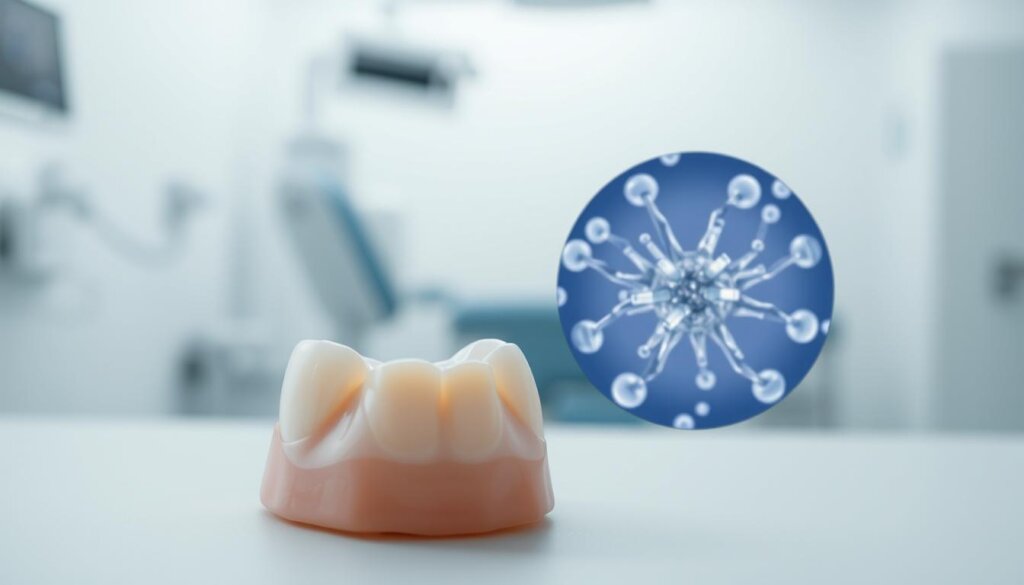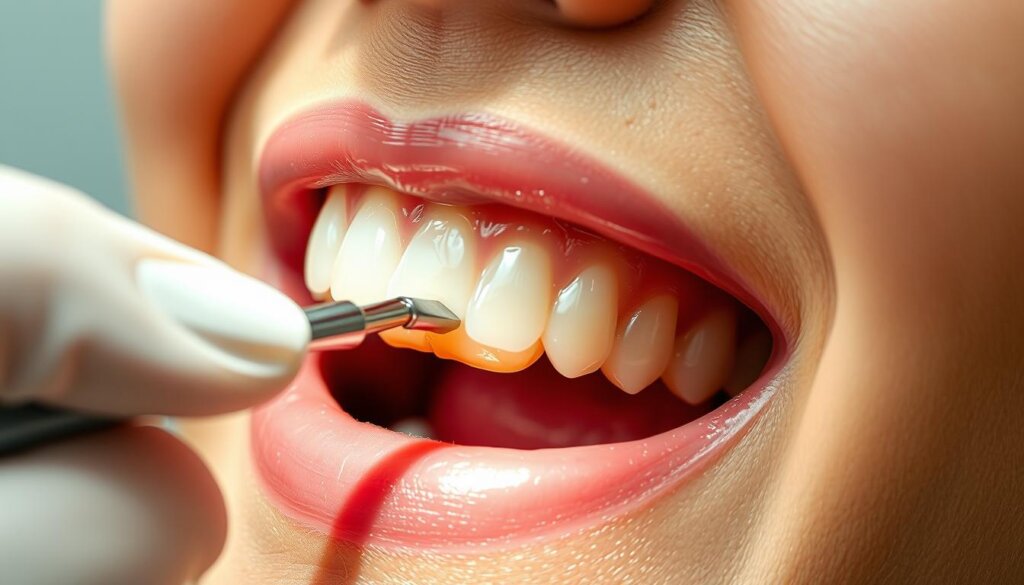How is a composite filling placed in the tooth?
Every year in the United States, dentists place over 175 million fillings, making it a common procedure. But not all fillings are the same. When looking at tooth cavity treatment, composite fillings shine because they work well and look good. They are a strong and hidden choice for people who don’t want the shiny look of metal. Knowing how a dentist puts in a composite filling helps us understand this advanced dental work.
Filling a tooth with composite is both scientific and artistic. It aims to make the tooth work and look like it did before. First, the dentist checks the tooth well, using images to see all the decay. They numb the area to make sure you’re comfortable. Next, they take out the decay carefully, saving as much of the tooth as they can. They clean the tooth and get it ready for the filling. The dentist puts on a bonding agent, adds layers of composite resin, and uses a special light to harden each layer. The real skill comes in shaping and polishing the filling, making sure it looks right and your bite is correct.
This careful process makes the filling look just like your tooth and strong enough for daily use. While the look is important, these fillings are also better for your tooth’s health and last a long time.
With so many fillings done, knowing more about this is key. The process affects how long the filling and the tooth last. It shows why choosing the right filling material and method is crucial.
Key Takeaways
- Composite fillings are a top choice for cavity treatment because they look real and last long.
- Learning how a composite filling is placed shows the mix of science and art in fixing teeth.
- The steps include a full dental check-up, removing decay carefully, and applying bonding and resin properly.
- Each resin layer is cured for a strong filling. Then, it’s shaped and polished to look natural.
- Dentists also make sure the bite is right and give care tips to keep the filling good for a long time.
Introduction to Composite Fillings
Composite fillings blend in with your tooth color, leading the charge in dental restoration techniques. They do more than just fill cavities. They fix teeth harmed by grinding or accidents too. At the heart of it is the composite resin application. This method uses plastic resins and glass particles. It makes sure the filling sticks well to your tooth, lasts long, and stands up to wear.
The way composite filling procedures have advanced allows dentists to keep more of your original tooth. Composite fillings set quickly under a special light. This is way faster than old methods. This quick setting is better for you. It makes your dental visit shorter and more comfortable.
For a natural look and restored function, composite fillings are the way to go. They’re versatile, good for small cosmetic changes or big fixes. This makes them a key part of modern dental restoration techniques.
What Are Composite Fillings?
Composite fillings are a big step forward in fixing teeth. They are made from a mix of plastic resin and powdered glass filler. These fillings look a lot like real teeth. That’s why many people choose them to keep their smiles looking natural.
Definition and Composition
Composite fillings have plastic resin and powdered glass filler in them. This mix makes the filling blend in well with the tooth and lasts a long time. The plastic lets the filling bend a bit, and the glass makes it strong and wear-resistant.
Benefits Over Other Fillings
Composite fillings stick tightly to the tooth. They need less tooth removal than amalgam fillings. Saving more of the natural tooth is better for lasting dental health.
These fillings set quickly with a curing light, saving time for the dentist and patient. They’re also flexible in use. They can fill holes, fix chips, or change tooth shape for a nicer smile.
| Feature | Composite Fillings | Amalgam Fillings |
|---|---|---|
| Material Composition | Plastic resin, powdered glass filler | Metal alloy (silver, mercury) |
| Aesthetic Appeal | Natural tooth appearance | Metallic, visible |
| Time of Procedure | Quick set under light | Longer hardening time |
Modern composite fillings have made dental care better looking and more effective. Choosing them means your teeth can look natural. Plus, it’s a tooth-friendly way to fix problems.
Reasons for Getting a Composite Filling
Composite fillings do more than just repair damage. They also make smiles look better. They fix teeth damaged by decay and improve how teeth look.
Tooth Decay
Composite fillings are great for treating cavities. They stop tooth decay from getting worse and make the tooth healthy again. The resin in these fillings sticks well to teeth, filling cavities and stopping decay.
Chipped or Cracked Teeth
If you have a chipped or cracked tooth, getting a dental filling for cracked teeth is important. Composite fillings bond to the tooth and fix its shape. This makes the tooth strong and protects it from more cracks.
Cosmetic Improvement
Composite fillings are big in aesthetic dental restorations. They match your tooth color, making them hard to notice. They fill gaps and fix color issues, making your smile look better.
The Preparation Phase for Composite Fillings
Getting ready for a composite filling starts with an important preparation for dental filling. This step is vital for understanding the dental work needed. It also helps in making sure the treatment goes well.
A first dental check-up is the beginning of this journey. At this check-up, a dentist looks closely at the person’s oral health. They decide if a composite filling is right. They talk about the person’s health history and dental issues, looking at everything that could affect oral health.
Initial Consultation with the Dentist
In the consultation, the dentist goes over the treatment options and what they involve. They focus on talking to the patient. This helps them choose the right treatment for the person’s needs and comfort.
Diagnostic Imaging and Assessment
After talking with the dentist, the next step is getting detailed scans. X-rays for cavities are done to see the tooth’s problem well. These scans are very important. They help find the decay, show how bad it is, and plan where to put the composite filling.
The preparation phase is all about being careful to make sure the best outcome. Every step is done carefully to prepare well for the composite filling. This makes sure the tooth works well and looks good again.
The Anesthesia Process
Dental procedures, like getting composite fillings, can make people anxious because of the expected discomfort. But thanks to better dental methods, including local anesthesia, these procedures can now be pain-free. This important step helps in controlling pain by using different numbing agents. It makes sure patients are comfortable.
Types of Anesthesia Used
First, dentists might use a pre-numbing gel before starting with anesthesia. This gel makes the injection less painful. It might be followed by local anesthesia, using drugs like Lidocaine or Mepivacaine. These drugs are chosen carefully, considering the patient’s health history and the procedure’s needs.
Importance of Pain Management
Local anesthesia does more than just numb the area. It also looks after the patient’s overall comfort during the dental work. Good pain management helps in making the dental work successful. It lets the dentist and patient focus on getting the best results, without pain getting in the way.
Knowing how local anesthesia works in dental procedures gives patients more confidence. It reassures them that their comfort is important.
Tooth Decay Removal
The process of removing tooth decay is a critical first step before placing a composite filling. This task ensures all infected areas are removed. This keeps the dental restoration secure. Dentists use a mix of tools and techniques to do this accurately.
High-speed dental drills are a top choice due to their effectiveness in clearing away decay. These drills, with their diamond burs, accurately target decay without harming the healthy tooth areas.
Caries indicator dye is also key in this process. It’s applied to the decay to highlight any residue by staining it. This way, only the healthy tooth remains, ready for the filling.
| Tool | Function | Benefit |
|---|---|---|
| High-speed dental drill | Removes decayed tooth material | Speed and precision in decay removal |
| Caries indicator dye | Stains decayed areas | Ensures complete removal of decay |
It’s crucial to have a clean tooth surface after removing decay for a successful filling. Using high-speed dental drills and caries indicator dye together helps remove tooth decay thoroughly. This preps the tooth perfectly for the composite filling.
Application of the Composite Material
Applying composite material to tooth fillings blends science with art. The main goal is to make the tooth work well and look natural. We explore the detailed steps of dental layering and how dentists sculpt tooth fillings artistically.
Layers of Composite Resin
Dentists use a layering technique with composite resin. This method gives the filling strength and a natural look. It mimics real teeth’s look and feel by balancing these properties.
- Base Layer: Provides strong support and hides any color changes below.
- Intermediate Layer: Adjusts the look, adding depth and lifelikeness.
- Top Layer: It’s polished to resist wear and mimic the shine of real teeth.
Techniques for Shaping and Molding
Sculpting tooth fillings is key when applying composite. It helps dentists rebuild the tooth’s natural shape. The goal is to look good and work well with other teeth.
- Strategic Material Placement: Composite is added carefully for the best structure and strength.
- Artistic Sculpting: Dentists use special tools to shape the composite like real teeth.
- Detailing and Finishing: Tiny tweaks are made to make sure the filling blends in perfectly.
Curing the Composite
Composite fillings have greatly improved in dentistry. These improvements help with how fast they set and their results. It’s important for dental experts to know the best ways to make these fillings harden properly.
Dentists often use LED curing lights on composite materials. This technology has made setting fillings faster and better. LED lights provide exact control. This is key to making sure each layer of resin hardens right, for strength and to stick well.
Light Curing vs. Self-Curing
The method chosen for curing impacts the filling’s strength and life. Light curing uses an LED light and a special wavelength to quickly harden the composite. This method is known for dependable, strong results in a short time.
Self-curing composites don’t need light to harden. They’re easier in hard-to-reach spots but don’t give as much control as LED curing.
Duration and Process
The curing time is vital for a composite filling. Using an LED curing light means using light for 10 to 40 seconds per layer. This varies with the resin’s type and thickness. The light starts a reaction that turns the material solid, making a strong bond quickly.
Here’s a look at how long it takes to cure different composites:
| Type of Composite | Average Curing Time (seconds) |
|---|---|
| Standard Composite | 20-40 |
| Bulk Fill Composite | 10-20 |
| Flowable Composite | 10-30 |
Doing the composite filling setting right is key. It’s important for the filling’s lasting power and the tooth’s health. This depends a lot on how well the filling binds during the hardening process.
In summary, choosing between light curing and self-curing is crucial. It greatly affects the success and durability of dental treatments. Using advancements like the LED curing light can majorly improve composite dental procedures.
Final Adjustments and Polishing
Once a composite filling is in, the dentist works on adjusting the dental bite. They also polish the fillings and finish the dental work. These steps are key for the filling to work right, last long, and feel good for the patient.
Importance of Bite Alignment
Getting the bite alignment right is key for the filling to last. If it’s off, it can cause discomfort, wear down the filling, and even damage it. Dentists adjust the bite carefully. This makes sure the fillings match the natural bite perfectly.
Finishing Techniques
The final touch is polishing the fillings so they’re smooth and look good. This step is not just about looks though. A smooth filling won’t gather as much plaque or stain easily. So, it helps the filling—and the whole dental work—last longer.
Post-Placement Care Instructions
After getting composite fillings, following the right aftercare steps is key for recovery and their long-term success. This dental filling aftercare guide aims to help patients take proper care of their new fillings. It promotes good oral health.
Taking care of composite fillings isn’t hard, but it needs you to pay attention and keep up with oral hygiene. By following these tips, the life of your fillings can be extended. It also helps prevent other dental problems.
Immediate Aftercare
- Don’t eat chewy, hard, or hot foods for at least 24 hours. This prevents harm or movement of the new filling.
- Stay away from alcohol and smoking until the numbness from anesthesia fades. This avoids accidents caused by numbness.
- Watch out for any strange pain or sensitivity. If it continues, see your dentist.
Right after the procedure, proper dental filling aftercare greatly helps the composite material in the fillings to set and become strong.
Long-term Maintenance Tips
- Make sure to have regular dental check-ups. This ensures your filling and the teeth next to it are healthy.
- Keep up with thorough daily oral hygiene. This includes brushing well twice a day and flossing every day.
- Eat fewer sugary foods and drinks that can stain. This helps avoid fillings from getting dull and decaying.
The advice on oral hygiene tells us that looking after your mouth and fillings is crucial. You need regular dentist visits and to take care of your teeth at home.
Signs You May Need a Replacement Filling
Composite fillings are known for being durable and looking good. However, they can wear out and might need to be replaced. It’s important to keep an eye on the lifespan of your composite filling for healthy teeth. If a filling needs replacing, there are usually clear signs. Knowing these signs helps you get the help you need quickly.
Going to the dentist regularly is key to catching problems with fillings early on. In our discussion, we’ll cover some major signs that suggest it’s time for a new filling. We’ll also offer advice on when to see your dentist.
Wear and Tear Indicators
- Visibility of cracks or fractures in the filling
- Fillings appearing worn out or flatter than usual
- Discoloration or staining of the composite material
These physical changes can weaken the filling. They might also cause discomfort or make your teeth more sensitive. This means you should see a dentist soon.
When to Consult Your Dentist
- Experiencing pain or discomfort around the filled tooth
- Noticeable gaps between the filling and the tooth enamel
- Recent incidents of biting hard substances followed by discomfort
It’s crucial to visit your dentist quickly if you have these issues. They’ll check how much wear or damage there is. Then, they can decide if your fillings need replacing.
Frequently Asked Questions About Composite Fillings
Dental patients often wonder about composite fillings FAQ. They ask about filling longevity and possible dental material allergies. This section gives current and science-based answers to these common worries.
Many are concerned with how long composite fillings last. Usually, they stay good for seven to twelve years. This depends a lot on how one lives and their dental care routine. To keep the filling longevity long, it’s crucial to brush and floss well. Also, seeing your dentist regularly is key.
Allergies and Sensitivities
Even though composite fillings are mostly safe, some people might be allergic or sensitive to them. Thankfully, the chance of dental material allergies is much lower with composite fillings. This is because they are made from a specific mix of plastic and fine glass particles. If you’re worried about allergies, talk to your dentist about getting a patch test before the filling is placed.
- Keep up good oral hygiene to stop the material from wearing down.
- Visit your dentist often to keep an eye on the filling’s condition.
- If you notice any sign of allergy or odd sensitivity, see a dentist right away.
To make sure composite fillings last long and stay healthy, take care of your dental health. Also, pay attention to how your body reacts to new materials.
Cost Considerations for Composite Fillings
Knowing what composite fillings will cost is key for anyone thinking about them for dental work. Prices change because of things like how skilled the dentist is, where the clinic is, and how tough the dental problem is.
Composite filling costs are usually more because they look better and last longer. They use top-notch materials and need careful work, which bumps up the price. Let’s look at what you might pay for composite fillings in the U.S., and see how dental insurance and financing dental treatment can help.
Average Costs in the United States
The table below shows the cost differences for composite fillings in various states:
| State | Lowest Cost | Highest Cost | Average Cost |
|---|---|---|---|
| New York | $150 | $450 | $300 |
| California | $125 | $400 | $262 |
| Texas | $100 | $350 | $225 |
| Florida | $120 | $380 | $250 |
| Illinois | $115 | $365 | $240 |
This data shows prices vary, making composite fillings a notable spend, especially if you need more than one. The difference between states highlights how local economies play a role.
Insurance Coverage and Financing Options
Managing the expense of composite fillings is possible in a few ways. Many dental insurance plans will cover part of the cost for these fillings. That’s especially true if they’re needed for health, not just looks.
If insurance won’t cover it all, or you don’t have insurance, financing dental treatment might work. A lot of dentists offer payment plans themselves or through other companies. This means you could pay over time. It’s smart to chat with your dental office to get all the details on these options.
In the end, even though composite fillings can cost more than other types, their benefits for your look and dental health are often worth it. With careful financial planning, including using insurance and payment plans, these treatments can be made affordable.
Comparing Composite Fillings with Other Materials
In the dental world today, the growth of filling materials is key in fixing teeth and caring for patients. The dental filling materials comparison often focuses on three types: composite, amalgam, and glass ionomer. Each material offers unique benefits and best uses.
Amalgam fillings were once favorite for their toughness and affordability. Yet, concerns over their mercury content have led to a decline in use. Now, many dentists prefer safer, more attractive options.
Amalgam vs. Composite
Amalgam stands out for its durability, perfect for back teeth that chew a lot. But, composite fillings look better and are less invasive. They can also match your tooth color closely.
Glass Ionomer Fillings
Glass ionomer fillings bond chemically with teeth and release fluoride to stop decay. They’re not as strong as amalgam or composite. Yet, they’re great for certain cases like fillings under the gum or for kids.
Choosing the right filling material affects your teeth’s health and look in the long run. Knowing about each material’s features helps pick what’s best for your dental needs.
The Role of Nutrition in Dental Health
Nutrition is key for great dental health. Knowing what foods to eat or avoid helps prevent cavities. It also helps dental treatments, like composite fillings, last longer.
Foods to Avoid
Stopping tooth decay is important for keeping teeth healthy. Some foods make decay worse and can harm teeth and fillings. Here’s what to steer clear of:
- Sugary foods and beverages: These boost bacteria and acid in your mouth.
- Hard candies and foods: These can physically harm teeth and fillings.
- Sticky or chewy foods: They stick to teeth and fillings, making cleaning tough. This leads to more exposure to harmful stuff.
Nutrient-Rich Options for Healthy Teeth
To keep teeth strong, add teeth-strengthening foods to your meals. These foods not only boost enamel but also keep your mouth healthy.
| Nutrient | Food Sources | Benefits |
|---|---|---|
| Calcium | Dairy products, leafy greens, almonds | Makes tooth enamel stronger and helps bones around teeth. |
| Phosphorus | Fish, red meat, eggs, tofu | Boosts enamel and bone health along with calcium. |
| Vitamins D and C | Fatty fish, citrus fruits, fortified cereals | Vitamin D helps absorb calcium. Vitamin C makes gums stronger. |
A diet full of these nutrients doesn’t just support dental health. It also helps in fighting tooth decay and keeps teeth strong through nourishment.
Conclusion: Maintaining Your Dental Health with Composite Fillings
Composite fillings are more than just repairs. They’re about keeping your teeth looking natural. They also use regenerative techniques for overall wellness. These fillings blend in with your teeth and are safe for your body. This shows how modern dentistry aims to improve health and tackle challenges.
Seeing your dentist regularly is key to making sure your fillings work right. They help keep your mouth healthy and your smile bright. It’s also important to talk with your dentist. This way, any issues with your fillings can be fixed fast, keeping your mouth healthy.
Composite fillings are a big step in keeping your teeth looking natural. They use new dental methods not just to fix, but also to make teeth better. We encourage everyone to learn about these fillings. And to make caring for your teeth a lifelong goal for a bright, healthy smile.






